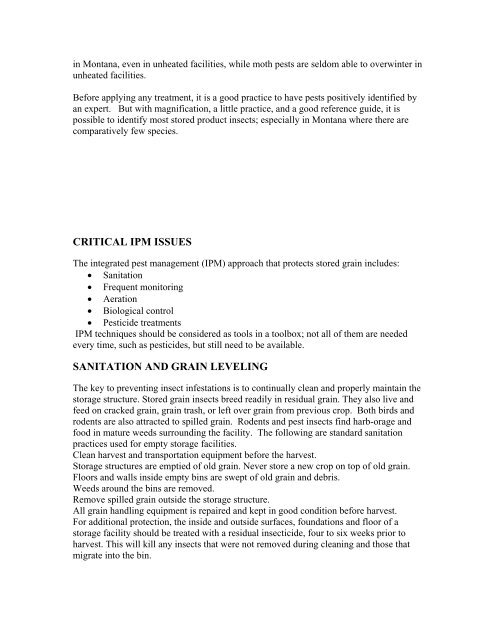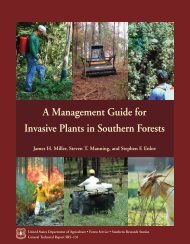identify insect species. The <strong>for</strong>ewings take many <strong>for</strong>ms. Inthe beetles, they are hard and shell-like; in the grasshoppers,they are leathery. The <strong>for</strong>e-wings of flies are membranous;those of true bugs are part membranous and part hardened.vertebrates.Abdomen - The abdomen is usually composed of 11segments, but 8 or fewer segments may be visible. Alongeach side of most of the segments are openings (calledspiracles) through which the insect breathes. In someinsects, the tip end of the abdomen has a tail-like appendage.Insects, unlike some other types of animals, have nobackbones. They have an outer supporting structure calledan exoskeleton. There<strong>for</strong>e they are called invertebrates.Organisms with an internal support structure (endoskeleton)which is characteristic of most large animals, are termed<strong>Stored</strong> <strong>Grain</strong> InsectsIn addition to obvious identifying characteristics, the feeding habits of storage insectpests are used to separate them into two classes: Primary pests and secondary invaders.Primary pests are those that are capable of penetrating and infesting intact kernels ofgrain, and have immature stages that can readily develop within a kernel of grain.Secondary invaders cannot infest sound grain but feed on broken kernels, debris, highermoisture weed seeds, and grain damaged by primary insect pests. In general, theimmature stages of these species are found external to the grain. It is often thought thatsecondary invaders cannot initiate an infestation. This is untrue as in almost any storagesituation there will be adequate amounts of broken grains and debris to support aninfestation by secondary invaders. Moreover, secondary invaders contribute directly tograin spoilage after establishment, just as primary pests do. However, the most damaginginsect types are those that feed within the kernel itself, causing insect-damaged-kernels(IDK). Wheat is discounted based on the number of insect-damaged-kernels (IDK) aswell as the presence of live insects, and other grain quality factors, when samples aregraded at the time of sale.In Montana, almost all stored-grain insects are beetles and weevils in the OrderColeoptera. There are rare occurrences of moth pests (Lepidoptera). Members of sevenother insect Orders are also found in grain storage throughout the world, but the majorpests are still primarily from the Coleoptera and the Lepidoptera.Insects from these two groups develop by complete metamorphosis; meaning they have(1) an egg stage, (2) multiple larval stages, (3) a pupal stage and , (4) the adult stage(Figure 1.2). Insects such as grass-hoppers and aphids pass through incomplete metamorphosiswith three stages: (1) egg, (2) nymph, and (3) adult. The immature stagesresemble and feed on the same food as adults (Figure 1.2). By con-trast, larval and adultbeetles that develop using complete metamorphosis feed on grain, while only theimmature <strong>for</strong>ms of the moth pests feed on the grain. Beetle pests are relatively common
in Montana, even in unheated facilities, while moth pests are seldom able to overwinter inunheated facilities.Be<strong>for</strong>e applying any treatment, it is a good practice to have pests positively identified byan expert. But with magnification, a little practice, and a good reference guide, it ispossible to identify most stored product insects; especially in Montana where there arecomparatively few species.CRITICAL IPM ISSUESThe integrated pest management (IPM) approach that protects stored grain includes:• Sanitation• Frequent monitoring• Aeration• Biological control• <strong>Pest</strong>icide treatmentsIPM techniques should be considered as tools in a toolbox; not all of them are neededevery time, such as pesticides, but still need to be available.SANITATION AND GRAIN LEVELINGThe key to preventing insect infestations is to continually clean and properly maintain thestorage structure. <strong>Stored</strong> grain insects breed readily in residual grain. They also live andfeed on cracked grain, grain trash, or left over grain from previous crop. Both birds androdents are also attracted to spilled grain. Rodents and pest insects find harb-orage andfood in mature weeds surrounding the facility. The following are standard sanitationpractices used <strong>for</strong> empty storage facilities.Clean harvest and transportation equipment be<strong>for</strong>e the harvest.Storage structures are emptied of old grain. Never store a new crop on top of old grain.Floors and walls inside empty bins are swept of old grain and debris.Weeds around the bins are removed.Remove spilled grain outside the storage structure.All grain handling equipment is repaired and kept in good condition be<strong>for</strong>e harvest.For additional protection, the inside and outside surfaces, foundations and floor of astorage facility should be treated with a residual insecticide, four to six weeks prior toharvest. This will kill any insects that were not removed during cleaning and those thatmigrate into the bin.
















